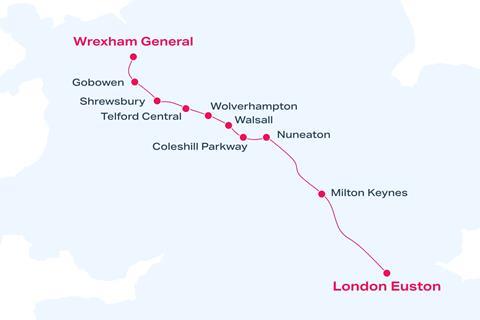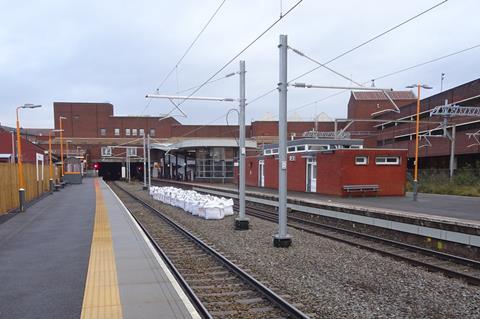Alstom and SLC Rail have spoken exclusively to Rail Business UK about their plans to launch an open access train service between London Euston and Wrexham which would make use of the latest technology, seek to exploit new business opportunities and benefit from changes in the passenger market.

UK: A formal application to launch an open access passenger service between North Wales and London was submitted to the Office of Rail & Road by the Wrexham, Shropshire & Midlands Railway joint venture of consultancy SLC Rail and Alstom on March 14.

Darren Horley, WSMR Mobilisation Director at Alstom, told Rail Business UK that entering the passenger market is a logical step for the supplier. The company aims to draw on its global operating experience and make use of its access to technology including HVO fuelling, real-time infrastructure monitoring equipment and potentially battery traction capabilities. ‘Alstom has all this technology in its hands’, he said. ‘It is all very exciting.’
‘The key things is to make the journey as easy as possible, from the second the passenger thinks about travelling with us, to when they park their car, board the train at the station, make the journey and when they depart from us’, Horley added. This will include taking into account older users and people with hidden disabilities. ‘It’s all about ease, friendliness and the environment on the train and the service offering.’

SLC Rail Managing Director Ian Walters told Rail Business UK that the ambition of WSMR was to offer new standards of customer service, with plans including a reservation system which would enable short-notice bookings and seat selection, and potentially instant delay repay so a passenger could receive a refund before they even get off a delayed train.
Service pattern

WSMR hopes that services could begin in mid-2025. It is proposing to operate five trains each way between Wrexham General and London Euston from Monday to Saturday, and four on Sundays.
Services would call at Gobowen, Shrewsbury, Telford Central, Wolverhampton, Walsall, Coleshill Parkway, Nuneaton and Milton Keynes, as well as the future Darlaston station when it opens.
The trains would use the currently freight-only Sutton Park line to avoid congestion in Birmingham, which WSMR said is already well served by rail.
Existing trainsets will initially be used, with details still to be confirmed. Consultation on the proposal was based on using Class 22x diesel trainsets; East Midlands Railway’s Bombardier Transportation Class 222 fleet is scheduled to become available as Hitachi Class 810 Aurora bi-mode trains are introduced on Midland Main Line inter-city services.
Wrexham is going places
WSMR would be wholly commercial operation, separate from government franchised rail operations and not receiving any subsidy. The partners expect to create around 50 jobs, mostly based in North Wales and the Midlands.
WSMR also has no links to the previous Wrexham & Shropshire open access service which ran in 2008-11.
The way the railway is used has changed since the W&S services ended, said Walters, and ‘we are now at exactly the time when this sort of operation is needed’.
WSMR’s services would be offer more competitive journey times by using a different route serving growing areas. WSMR estimates it would have a core catchment area of around 1·5 million people outside London, and this population is set to grow by 16% over the next decade.
As an open access operator, it will have the flexibility to respond to market needs and ‘make our own decisions on a commercial basis’ without the constraints of a government contract, and Walters said ‘we want to maximise every opportunity that comes up’.
SLC aims to support ‘evolution’ once the services are running. ‘A lot of our directors are ex-train operating company people, we are a consultancy business but we are operators at heart’, explained Walters. WSMR ‘is going to have a slightly different feel to traditional open access’, with SLC planning to use its expertise to seek development opportunities along the route and work with local authorities to attract third party funding for projects such as new stations and car parks.
He said ‘Wrexham is going places’, and the football club is now ‘on the map’ internationally thanks to investment by Hollywood actors Ryan Reynolds and Rob McElhenny, which has led to the hit Welcome to Wrexham TV series. Future possibilities include the operation of charter trains for the club.
The next logical step

WSMR would be Alstom’s first direct involvement in train operation in the UK, although it operates services under contract in North America, the Middle East, North Africa Region and Asia-Pacific.
Maintenance contracts mean ‘we are the largest rail services provider in the UK, so it is the next logical step for is to move from maintaining and providing trains into running services’, said Horley
‘It is not new to Alstom, we have got over 40 years of experiences of operating and maintaining rail systems globally and over 50 active contracts around the world.’
New entrant
Horley said Alstom is responding to the government’s ‘positive steps’ towards encouraging new operators into the market. The company could also be interested in bidding for concession contracts in the future.
The Department for Transport has provided WSMR with a letter of support in principle, and Rail Minister Huw Merriman said ‘competition delivers choice for passengers and drives up standards, which is why we continue to work with industry to help make the most of open access’.
Commenting on WSMR’s plans, Andy Bagnall, CEO of operators’ association Rail Partners, said experience on the East Coast Main Line and across Europe ’shows that where more commercial freedom exists for operators, it leads to better service, cheaper fares and greater efficiencies’.
He added that ’government should make it a priority to remove barriers to open access operations now and during the next parliament, in parallel to wider reform that harnesses private sector operators within a new public body’.



